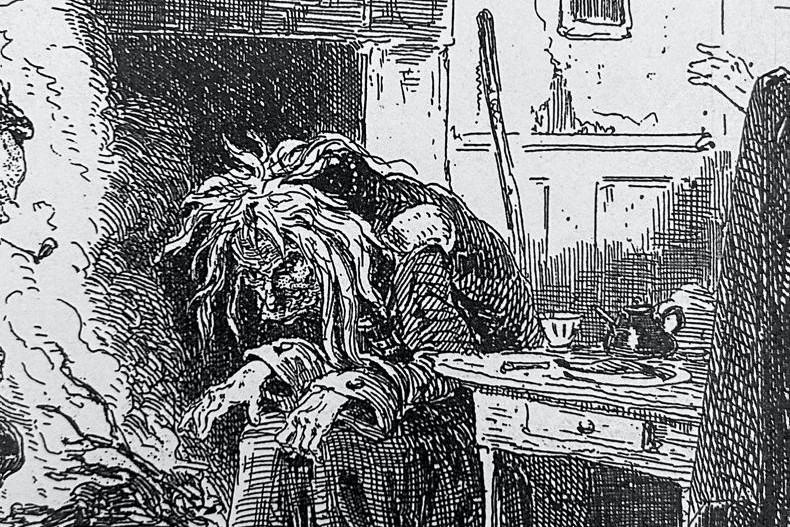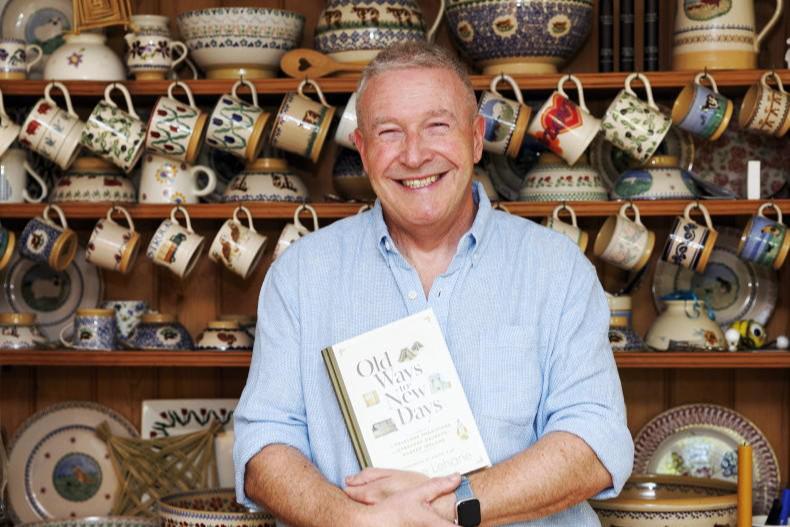There is an old saying: “A pot of nettles in May is health for a year and a day.” It was traditional to have three feeds of nettles between May Day and Old May Day (11 May). There are similar recommendations for nettles to be consumed on three Fridays in March and during spring in general, but what is clear is that the intake of nettles to clean the blood and tone up the system was a very popular activity in the past.
The nettles that were gathered would have to have been young and tender, not from under the trees and not when they were in flower. It was best to pick the new growth off the tips where the leaves were soft and supple. Needless to say, it was important not to be stung and, in the past, the women’s thick, knitted, woollen, soleless stockings, “máirtíní”, were worn on the hands and arms to prevent contact with the stinging plant.
Inevitably, people did get stung, but then the dock leaf was always close at hand. The flat, cold, leaf was applied to the sting and sometimes a charm such as “docken, docken cure me, nettles, nettles have burned me” was recited six times to effect relief.
For many, a plate of fresh nettles featured as a regular and highly prized component of the diet and the boiled leaves were eaten in the same way as cabbage. They were also mixed with mashed potatoes to make a nettle champ or colcannon. They were made into all manner of other preparations from teas and brews to steaming bowls of nourishing green soup. Whichever the recipe, the young leaves were stripped from the long stringy stalks, chopped up and boiled for a half an hour or so. If the leaves were to be eaten, two separate boilings took place, discarding the water from the first boil.
Traditional cures
The old people used to keep a bottle of nettle juice in the house as a regular traditional medicine for all sorts of ailments. The soft leaves were boiled and simply placed in a cup and presented to the patient who ate the leaves.
This panacea was called into use for blood pressure, stomach trouble, pimples, bad breath, varicose veins and dull eyes, with the leaves also being applied to any sort of rash, sore or abscess
Sometimes, the boiled leaves were put in milk, while other references suggested adding sugar or honey and bottling the preparation for regular use. This panacea was called into use for blood pressure, stomach trouble, pimples, bad breath, varicose veins and dull eyes, with the leaves also being applied to any sort of rash, sore or abscess.
Nettle roots were boiled and these were thought to help pleurisy. Nettles were thought to be particularly effective against measles and were also called into direct use for whooping cough.
Whatever their efficacy, the nettles seem to have been far more effective than the other cures recommended for whooping cough, which included going to a house where the husband and wife have the same name, passing between the legs of the donkey, consulting someone who owned a white horse and eating a ferret’s droppings.
The health of farm animals was also somewhat dependant on the choice use of nettles, with fluke in cattle remedied by its use. The main application was for fowl, especially for turkeys and ducks who suffered from “pip” (inflammation of their nostrils). When the nettles were chopped up and mixed with their feed of oatmeal, the young turkeys and ducks would grow hardy. As one account suggests: “Only for the nettles there’d be no turkeys raised.”
Subjecting the body to a severe stinging of nettles was the remedy for those who suffered from rheumatic pain. One account tells of a man who suffered terrible pain in his leg and, on the advice of a priest, he got his daughter to flail his naked leg with a handful of nettles until there was not a leaf left on them. When she had finished, he went to bed and his leg was covered in blisters, each the size of a half-crown. After three or four days, the blisters had disappeared, the pain had vanished and he was able to walk again.
Nettlesome night
In west Cork, nettles formed an integral part of the May eve celebration, which was known as “Nettlesome Night”. Here, teenage boys and girls went around with a bunch of nettles concealed on their persons and when they came across one of their friends, male or female, a fencing battle of nettles ensued.
The so-called “nettling” often resulted in severe stings. The same custom is recorded by Anna Maria Hall and her husband Samuel Carter Hall in 1841 in a custom peculiar to Cork city. They record: “May eve, the last day of April, is called ‘Nettlemas night’. Boys parade the streets with large bunches of nettles, stinging their playmates and occasionally bestowing a sly touch upon strangers who come in their way. Young and merry maidens, too, not infrequently avail themselves of the privilege to ‘sting’ their lovers – and the laughter in the street is often echoed in the drawing-room.”
Some customs are better left in the past. This Sunday night is the night of nettles and whatever about sneaking up and nettling the person you fancy with a thrashing bouquet of stinging greenery, why not search out this much-maligned free food and prepare a nice soup or champ and treat yourself to the time-honoured three feeds in the month of May.
Shane Lehane is a folklorist who works in UCC and Cork College of FET, Tramore Road Campus. Contact: shane.lehane@csn.ie
Read more
Folklore with Shane Lehane: the bog in May
Folklore: the Stócach at Shrove
There is an old saying: “A pot of nettles in May is health for a year and a day.” It was traditional to have three feeds of nettles between May Day and Old May Day (11 May). There are similar recommendations for nettles to be consumed on three Fridays in March and during spring in general, but what is clear is that the intake of nettles to clean the blood and tone up the system was a very popular activity in the past.
The nettles that were gathered would have to have been young and tender, not from under the trees and not when they were in flower. It was best to pick the new growth off the tips where the leaves were soft and supple. Needless to say, it was important not to be stung and, in the past, the women’s thick, knitted, woollen, soleless stockings, “máirtíní”, were worn on the hands and arms to prevent contact with the stinging plant.
Inevitably, people did get stung, but then the dock leaf was always close at hand. The flat, cold, leaf was applied to the sting and sometimes a charm such as “docken, docken cure me, nettles, nettles have burned me” was recited six times to effect relief.
For many, a plate of fresh nettles featured as a regular and highly prized component of the diet and the boiled leaves were eaten in the same way as cabbage. They were also mixed with mashed potatoes to make a nettle champ or colcannon. They were made into all manner of other preparations from teas and brews to steaming bowls of nourishing green soup. Whichever the recipe, the young leaves were stripped from the long stringy stalks, chopped up and boiled for a half an hour or so. If the leaves were to be eaten, two separate boilings took place, discarding the water from the first boil.
Traditional cures
The old people used to keep a bottle of nettle juice in the house as a regular traditional medicine for all sorts of ailments. The soft leaves were boiled and simply placed in a cup and presented to the patient who ate the leaves.
This panacea was called into use for blood pressure, stomach trouble, pimples, bad breath, varicose veins and dull eyes, with the leaves also being applied to any sort of rash, sore or abscess
Sometimes, the boiled leaves were put in milk, while other references suggested adding sugar or honey and bottling the preparation for regular use. This panacea was called into use for blood pressure, stomach trouble, pimples, bad breath, varicose veins and dull eyes, with the leaves also being applied to any sort of rash, sore or abscess.
Nettle roots were boiled and these were thought to help pleurisy. Nettles were thought to be particularly effective against measles and were also called into direct use for whooping cough.
Whatever their efficacy, the nettles seem to have been far more effective than the other cures recommended for whooping cough, which included going to a house where the husband and wife have the same name, passing between the legs of the donkey, consulting someone who owned a white horse and eating a ferret’s droppings.
The health of farm animals was also somewhat dependant on the choice use of nettles, with fluke in cattle remedied by its use. The main application was for fowl, especially for turkeys and ducks who suffered from “pip” (inflammation of their nostrils). When the nettles were chopped up and mixed with their feed of oatmeal, the young turkeys and ducks would grow hardy. As one account suggests: “Only for the nettles there’d be no turkeys raised.”
Subjecting the body to a severe stinging of nettles was the remedy for those who suffered from rheumatic pain. One account tells of a man who suffered terrible pain in his leg and, on the advice of a priest, he got his daughter to flail his naked leg with a handful of nettles until there was not a leaf left on them. When she had finished, he went to bed and his leg was covered in blisters, each the size of a half-crown. After three or four days, the blisters had disappeared, the pain had vanished and he was able to walk again.
Nettlesome night
In west Cork, nettles formed an integral part of the May eve celebration, which was known as “Nettlesome Night”. Here, teenage boys and girls went around with a bunch of nettles concealed on their persons and when they came across one of their friends, male or female, a fencing battle of nettles ensued.
The so-called “nettling” often resulted in severe stings. The same custom is recorded by Anna Maria Hall and her husband Samuel Carter Hall in 1841 in a custom peculiar to Cork city. They record: “May eve, the last day of April, is called ‘Nettlemas night’. Boys parade the streets with large bunches of nettles, stinging their playmates and occasionally bestowing a sly touch upon strangers who come in their way. Young and merry maidens, too, not infrequently avail themselves of the privilege to ‘sting’ their lovers – and the laughter in the street is often echoed in the drawing-room.”
Some customs are better left in the past. This Sunday night is the night of nettles and whatever about sneaking up and nettling the person you fancy with a thrashing bouquet of stinging greenery, why not search out this much-maligned free food and prepare a nice soup or champ and treat yourself to the time-honoured three feeds in the month of May.
Shane Lehane is a folklorist who works in UCC and Cork College of FET, Tramore Road Campus. Contact: shane.lehane@csn.ie
Read more
Folklore with Shane Lehane: the bog in May
Folklore: the Stócach at Shrove









SHARING OPTIONS